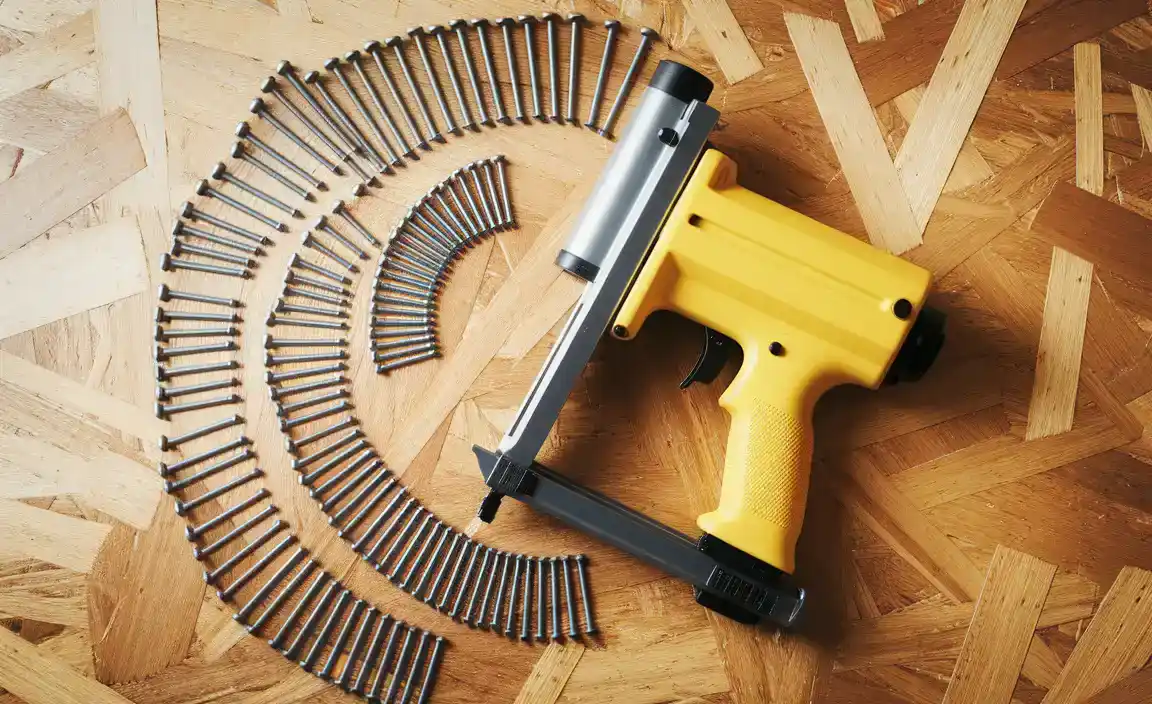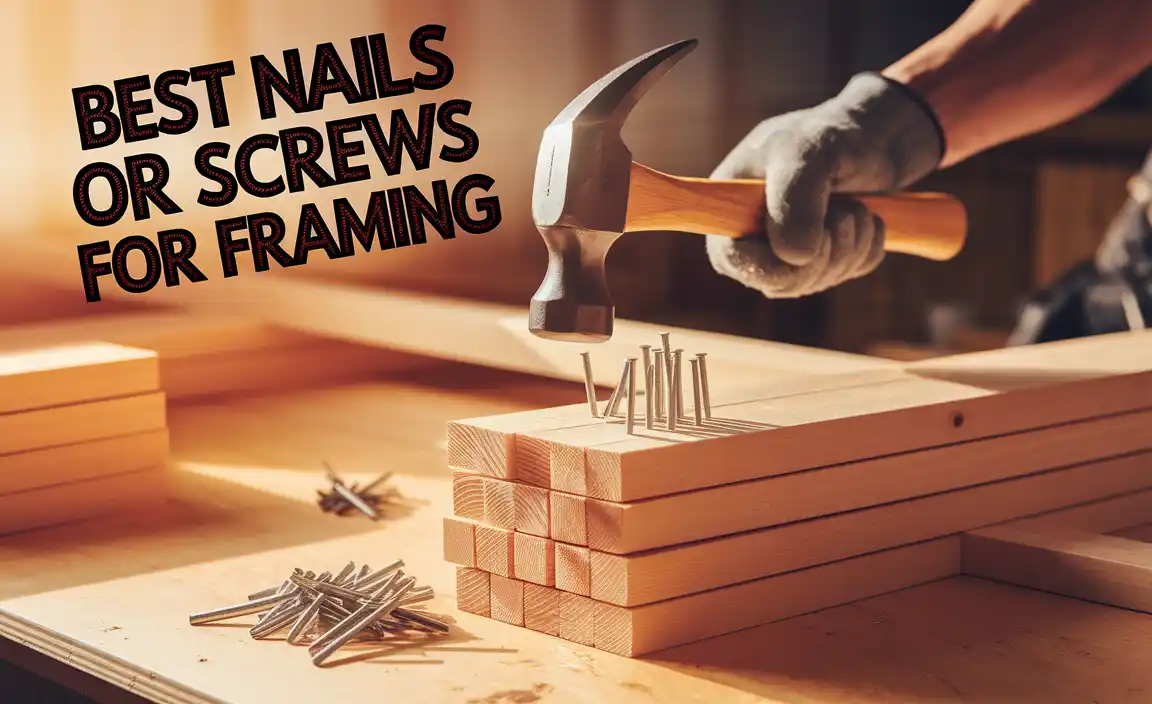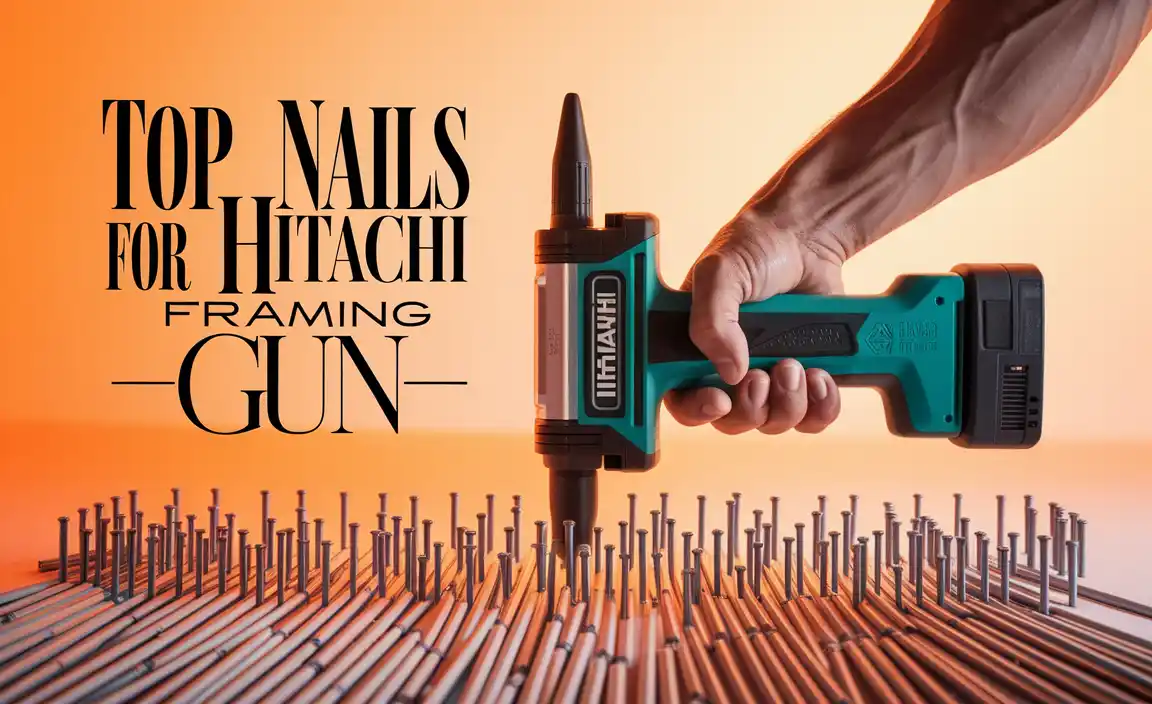Have you ever wondered what tools to use for your next project? If you’re planning to build something cool, you might hear about framing nailers and brad nailers. But what do they really do? Each tool has its own special job.
Framing nailers are like the big superheroes of construction. They help build the frame of a house or a deck. They shoot large nails into thick wood quickly. On the other hand, brad nailers are smaller and easier to handle. They use tiny nails to attach smaller pieces, like molding or trim.
Imagine you want to hang a picture on the wall. A brad nailer is perfect for that job. But if you’re building a treehouse? You’ll need a strong framing nailer. Knowing the right tool can make your work so much easier!
In this article, we’ll dive into the world of framing nailers vs brad nailers. You’ll learn when to use each one and why it matters for your projects. Are you ready to pick your tool?
Table of Contents
Framing Nailer Vs Brad Nailer Uses: Which One To Choose? When It Comes To Woodworking And Construction Projects, Choosing The Right Type Of Nailer Is Crucial For Achieving The Best Results. Two Popular Types Of Nailers Are The Framing Nailer And The Brad Nailer. Understanding Their Uses And Differences Can Help You Make An Informed Decision On Which Tool To Use For Your Specific Project. What Is A Framing Nailer? A Framing Nailer Is A Powerful Tool Designed For Heavy-Duty Fastening Tasks, Often Used In The Construction Of Wooden Structures Such As Walls, Decks, And Roofs. It Typically Shoots Larger Nails (Usually 2 To 3.5 Inches In Length) And Is Best Suited For Projects That Require Strong Structural Support. Uses Of A Framing Nailer 1. **Structural Framing**: Ideal For Quickly Assembling The Framework Of Buildings. 2. **Decking**: Perfect For Attaching Heavy-Duty Deck Boards Securely. 3. **Roofing**: Used For Fastening Rafters And Trusses Due To Its Powerful Drive. 4. **Sheathing**: Suitable For Quick Installation Of Plywood Or Osb On Homes. What Is A Brad Nailer? A Brad Nailer Is A Lighter, More Versatile Tool Designed For Precise And Delicate Tasks. It Shoots Smaller Nails (Usually 18-Gauge, Around 1 To 2 Inches In Length) And Is Commonly Used For Finish Work Or Applications Where Visibility Of The Nail Is A Concern, Such As Trim And Molding. Uses Of A Brad Nailer 1. **Finish Work**: Perfect For Nailing Trim, Crown Molding, Or Baseboards. 2. **Cabinetry**: Effective For Assembling Furniture And Cabinets. 3. **Decorative Projects**: Ideal For Crafts And Smaller Projects Requiring Finesse Without Leaving Large Holes. 4. **Paneling**: Suitable For Attaching Thin Panels Without Splitting The Wood. Key Differences Between Framing Nailer And Brad Nailer While Both Tools Serve Unique Purposes, There Are Distinct Differences That Can Influence Your Choice: – **Nail Size**: Framing Nailers Use Larger Nails For Strong Structural Applications, While Brad Nailers Use Smaller Nails For Finer Work. – **Power**: Framing Nailers Provide More Power And Are Bulkier, Whereas Brad Nailers Are Lightweight And Easier To Handle For Detailed Work. – **Application Area**: Framing Nailers Are Better Suited For Construction Projects, While Brad Nailers Excel In Finishing Tasks And Delicate Installations. Conclusion In Summary, The Choice Between A Framing Nailer And Brad Nailer Comes Down To The Task At Hand. If You Need To Tackle Large Construction Projects Requiring Strong, Sturdy Frame Connections, A Framing Nailer Is The Right Tool. For Precise Finish Work Or Delicate Projects, A Brad Nailer Is Your Best Bet. Investing In The Appropriate Tool Will Not Only Enhance Your Efficiency But Also Improve The Quality Of Your Work.

Framing Nailer vs Brad Nailer Uses
When choosing between a framing nailer and a brad nailer, consider your project type. A framing nailer drives larger nails, making it ideal for heavy tasks like building frames. It secures wood pieces firmly. On the other hand, a brad nailer uses smaller nails, perfect for delicate tasks like attaching trim or molding without splitting the wood. Would you rather have a sturdy frame or a fine finish? Understanding these tools helps you work smarter, not harder.What is a Framing Nailer?
Description and types of framing nailers. Common applications for framing nailers.A framing nailer is a powerful tool designed to drive larger nails quickly into wood. It’s like a magician’s wand, but for construction! There are two main types: the coil nailer and the stick nailer. The coil nailer holds a spiral of nails while the stick nailer uses straight strips. It’s perfect for framing houses, decks, and building furniture. Want to build a treehouse? Grab a framing nailer, and you’ll be the coolest kid on the block!
| Type of Framing Nailer | Uses |
|---|---|
| Coil Nailer | Great for roofing and sheathing. |
| Stick Nailer | Perfect for framing walls and large projects. |
What is a Brad Nailer?
Description and types of brad nailers. Common applications for brad nailers.A brad nailer is a tool used to drive small nails, called brads, into wood. These nails are thin and don’t leave big holes. There are two main types of brad nailers: electric and pneumatic. Electric brad nailers are powered by batteries or electricity. Pneumatic brad nailers use air pressure. Common uses for brad nailers include attaching trim, building projects, and crafts. They are perfect for light jobs where you want to avoid large nails.
What are the applications for a brad nailer?
Brad nailers work well for small projects. They are used in:
- Decorating with moldings.
- Attaching small wooden pieces.
- Craft projects like picture frames.
Using a brad nailer helps keep your work neat and tidy!
Key Differences Between Framing Nailers and Brad Nailers
Size and type of nails used. Power and driving capability comparisons.Framing nailers and brad nailers are tool buddies with different jobs! The size of nails they use is key. Framing nailers pack a punch with larger nails for heavy tasks. Meanwhile, brad nailers use smaller nails—perfect for light jobs like crafting. When it comes to power, framing nailers drive nails deep into tough materials like wood, while brad nailers are more gentle, great for delicate work. Think of it this way: framing nailers are the bodybuilders of tools, and brad nailers are the artists!
| Feature | Framing Nailer | Brad Nailer |
|---|---|---|
| Nail Size | Large (3 to 4 inches) | Small (1 to 2 inches) |
| Power | High | Medium |
| Best For | Heavy-duty tasks | Light-duty tasks |
When to Use a Framing Nailer
Ideal projects suited for framing nailers. Benefits of using a framing nailer in construction.Using a framing nailer is perfect for big projects like building walls, roofs, and decks. These tools drive large nails quickly and powerfully, cutting down your work time. Plus, they hold up under pressure, so your structures will stay strong. Imagine trying to build a treehouse with a stapler instead—no thanks! Here’s a quick look at some advantages:
| Benefits |
|---|
| Speed: Finish tasks faster. |
| Strength: Durable connections for heavy loads. |
| Accuracy: Nails go exactly where you want them. |
In short, a framing nailer helps you tackle big jobs efficiently. Just think of it as the superhero of construction tools! Why use a hammer when you can wield the power of a framing nailer?
When to Use a Brad Nailer
Ideal projects suited for brad nailers. Advantages of using a brad nailer in woodworking.Feeling crafty? A brad nailer is your best buddy for small projects like building a picture frame or putting together a bookshelf. It’s perfect for thin materials since it uses smaller nails, which means less wood splitting. With a brad nailer, you’ll get clean holes and a tidy finish—just like magic! Plus, it’s easy to hold, making it great for beginners. Why use a hammer and risk a headache when a brad nailer can do the job with a smile?
| Advantages of Brad Nailer | Ideal Projects |
|---|---|
| Less damage to wood | Picture frames |
| Cleans up fast with no splitting | Cabinet making |
| Lightweight and user-friendly | Woodworking crafts |
Pros and Cons of Each Nailer
Advantages of framing nailers. Disadvantages of framing nailers. Advantages of brad nailers. Disadvantages of brad nailers.Framing nailers and brad nailers each have their strong points and weak spots. Here are the main advantages and disadvantages:
- Framing Nailers:
- Advantages: Fast and strong. Great for heavy wood projects. Can hold large pieces together well.
- Disadvantages: Bulky and heavy. Can damage the wood if used incorrectly. Not good for delicate work.
- Brad Nailers:
- Advantages: Light and easy to use. Perfect for small, delicate projects. Leaves tiny holes that are easy to hide.
- Disadvantages: Not as strong for big projects. Can’t hold heavy materials well.
What is a brad nailer used for?
A brad nailer is used for small projects like trim work, crafts, and cabinetry. It helps attach light pieces without splitting or damaging the wood.
What is a framing nailer best for?
Framing nailers are best for construction projects, like building walls and decks. They use larger nails for strong support.
Choosing the Right Nailer for Your Project
Factors to consider when selecting a nailer. Tips for determining your specific needs.Picking the right nailer for your project feels daunting, but it’s really about understanding your needs. First, think about the material you are using. If you need to attach thick boards, a framing nailer is your best friend. It loves big jobs! If you’re working on delicate trim, a brad nailer keeps it classy without leaving big holes. Consider your project size, too. Are you building a treehouse or fixing a picture frame? That can change everything!
| Project Type | Recommended Nailer |
|---|---|
| Heavy-duty construction | Framing Nailer |
| Light furniture assembly | Brad Nailer |
| Trim work | Brad Nailer |
| Decking | Framing Nailer |
Also, consider how often you’ll use it. If it’s just for a weekend project, a brad nailer is lighter and easier to handle. If you plan to nail daily, a framing nailer might be worth the investment. So, ask yourself—what are you really nailing down?
Maintenance and Safety Tips for Nailers
Routine maintenance for optimal performance. Safety precautions when using nail guns.Taking care of your nailers is key for great results and safety. Regular cleaning keeps them running smoothly. Check for jams and ensure proper lubrication to avoid sticky situations—like trying to nail without coffee! Always wear safety glasses and gloves. Nail guns are powerful, so keep fingers clear of the trigger when not in use. Here’s a simple table to remember these tips:
| Maintenance Tips | Safety Precautions |
|---|---|
| Clean after each use | Wear safety glasses |
| Lubricate regularly | Keep hands away from the trigger |
| Inspect for damage | Check nail supply before starting |
With these tips, you can nail your projects like a pro while staying safe!
Conclusion
In summary, choose a framing nailer for heavy tasks like building decks. Opt for a brad nailer for lighter work, like crafting or trimming. Each tool has its special purpose. We encourage you to explore more about these tools online or try them out. Doing so will help you decide which is best for your projects!FAQs
Sure! Here Are Five Related Questions On The Topic Of Framing Nailers Vs. Brad Nailers:Framing nailers and brad nailers are both tools for nailing things together. A framing nailer uses bigger nails. It’s great for heavy work, like building walls. A brad nailer uses smaller nails. It’s good for lighter projects, like putting up trim. You choose the tool based on what you need to fix or build.
Sure! Please provide the question you’d like me to answer.
What Are The Primary Differences In Size And Type Of Nails Used By Framing Nailers And Brad Nailers?Framing nailers use big nails, called framing nails, which are about 2 to 3.5 inches long. We use these to build strong things like walls or decks. Brad nailers, on the other hand, use tiny nails called brad nails. These are usually 1 to 2 inches long and are great for small projects like attaching trim. So, framing nails are bigger, while brad nails are small.
In What Specific Woodworking Or Construction Projects Is A Framing Nailer More Advantageous Than A Brad Nailer?A framing nailer is great for big projects like building houses or fences. It uses thicker nails that hold heavy pieces together tightly. You would use it for wood frames, walls, and roofs. A brad nailer is better for small jobs like putting on trim or crafting. So, if you’re doing something strong and large, go for the framing nailer!
Can A Brad Nailer Be Used For Heavy-Duty Applications, Or Is It Strictly For Lighter Tasks?A brad nailer is best for lighter tasks, like attaching small wood pieces or trim. It uses thin nails called brads that don’t hold heavy things very well. For heavy-duty jobs, you might need a bigger tool, like a framing nailer. So, we should save the brad nailer for lighter projects.
How Does The Power And Depth Of Drive Differ Between Framing Nailers And Brad Nailers, And How Does This Affect Their Respective Uses?Framing nailers are stronger than brad nailers. They can drive big nails deep into wood. This makes them great for building things like houses. Brad nailers are less powerful and better for small projects, like attaching trim. We use framing nailers for heavy work and brad nailers for lighter tasks.
What Are The Safety Considerations And Handling Techniques One Should Keep In Mind When Using A Framing Nailer Compared To A Brad Nailer?When using a framing nailer, you should always wear safety goggles. They protect your eyes from flying nails. Make sure to keep your hands away from the tip when firing. A framing nailer uses bigger nails, so it can be more dangerous than a brad nailer. Always keep it pointed away from yourself and others, and never try to catch a falling nail.
{“@context”:”https://schema.org”,”@type”: “FAQPage”,”mainEntity”:[{“@type”: “Question”,”name”: “Sure! Here Are Five Related Questions On The Topic Of Framing Nailers Vs. Brad Nailers:”,”acceptedAnswer”: {“@type”: “Answer”,”text”: “Framing nailers and brad nailers are both tools for nailing things together. A framing nailer uses bigger nails. It’s great for heavy work, like building walls. A brad nailer uses smaller nails. It’s good for lighter projects, like putting up trim. You choose the tool based on what you need to fix or build.”}},{“@type”: “Question”,”name”: “”,”acceptedAnswer”: {“@type”: “Answer”,”text”: “Sure! Please provide the question you’d like me to answer.”}},{“@type”: “Question”,”name”: “What Are The Primary Differences In Size And Type Of Nails Used By Framing Nailers And Brad Nailers?”,”acceptedAnswer”: {“@type”: “Answer”,”text”: “Framing nailers use big nails, called framing nails, which are about 2 to 3.5 inches long. We use these to build strong things like walls or decks. Brad nailers, on the other hand, use tiny nails called brad nails. These are usually 1 to 2 inches long and are great for small projects like attaching trim. So, framing nails are bigger, while brad nails are small.”}},{“@type”: “Question”,”name”: “In What Specific Woodworking Or Construction Projects Is A Framing Nailer More Advantageous Than A Brad Nailer?”,”acceptedAnswer”: {“@type”: “Answer”,”text”: “A framing nailer is great for big projects like building houses or fences. It uses thicker nails that hold heavy pieces together tightly. You would use it for wood frames, walls, and roofs. A brad nailer is better for small jobs like putting on trim or crafting. So, if you’re doing something strong and large, go for the framing nailer!”}},{“@type”: “Question”,”name”: “Can A Brad Nailer Be Used For Heavy-Duty Applications, Or Is It Strictly For Lighter Tasks?”,”acceptedAnswer”: {“@type”: “Answer”,”text”: “A brad nailer is best for lighter tasks, like attaching small wood pieces or trim. It uses thin nails called brads that don’t hold heavy things very well. For heavy-duty jobs, you might need a bigger tool, like a framing nailer. So, we should save the brad nailer for lighter projects.”}},{“@type”: “Question”,”name”: “How Does The Power And Depth Of Drive Differ Between Framing Nailers And Brad Nailers, And How Does This Affect Their Respective Uses?”,”acceptedAnswer”: {“@type”: “Answer”,”text”: “Framing nailers are stronger than brad nailers. They can drive big nails deep into wood. This makes them great for building things like houses. Brad nailers are less powerful and better for small projects, like attaching trim. We use framing nailers for heavy work and brad nailers for lighter tasks.”}},{“@type”: “Question”,”name”: “What Are The Safety Considerations And Handling Techniques One Should Keep In Mind When Using A Framing Nailer Compared To A Brad Nailer?”,”acceptedAnswer”: {“@type”: “Answer”,”text”: “When using a framing nailer, you should always wear safety goggles. They protect your eyes from flying nails. Make sure to keep your hands away from the tip when firing. A framing nailer uses bigger nails, so it can be more dangerous than a brad nailer. Always keep it pointed away from yourself and others, and never try to catch a falling nail.”}}]}



